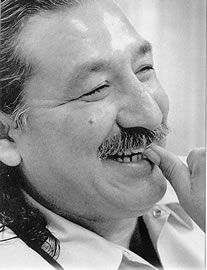|

Case against Peltier's innocence builds
American Indian reporter also uncovers unsettling
evidence on Anna Mae Aquash murder
By Len Kruzenga
The First Perspective
Fiat justitia-ruat caelum "Do justice, and let the
skies fall."
For over three decades the defining moment of the American
Indian movement-its occupation of the Pine Ridge SD. reserve-and
the murder of two FBI agents there have been part (many
would say too small a part) of America's contemporary
historical awareness, and an immense part of the North
American Indian community's political identity on both
sides of the 48th parallel.
For Native people and groups Peltier's name became synonymous
with injustice, with political struggle and the rebirth
of North American Indian cultural, political and social
activism.
To this day Peltier's name is still regularly invoked
at host of Native cultural and political activities across
North America-from pow-wows to $250 a plate business dinners
to capitalize on the galvanizing resonance of his cause
and that of the American Indian Movement (AIM).
Peltier's image has spawned a separate cottage industry
devoted to transferring his likeness on buttons, pins
and bumper stickers and, by extension, spread the word
of his cause across the world.
As one young Ojibway man told me recently, "He's
the Indian Che Guevara"
However, invoking the images of all that occurred during
and following the struggle at the Pine Ridge Indian Reserve
in the 70s for cultural and political purposes has also
ultimately rendered the uncomfortable specifics of that
time almost inconsequential. Specifics such as the murder
of Anna Mae Aquash and the death of two FBI agents, and
the psychological and physical toll upon Ogala Sioux people
caught between two opposing forces; that of the tribal
government of that period and the government agencies
sent in to support its corrupt and oppressive regime,
and that of AIM, intent on overthrowing the tribal government.
Somehow along the way the relatively unknown and all but
forgotten victims of that period were willingly sacrificed
by both sides, the government and AIM, to some nebulous
concept of a greater-and always treacherously shifting-political
good.
But when the CBC's Fifth Estate aired a documentary on
the unsolved murder of AIM member Anna Mae Aquash it became
obvious that the uncomfortable past would not stay buried.
News From Indian Country Editor and reporter Paul Demain
has been covering the story intensively for well over
20 years.
As discussed in a recent telephone conversation with the
First Perspective, Demain underscored that the case of
Peltier's guilt or innocence has taken on near mythic
proportions with the Native community, who are generally
convinced that AIM and Peltier were the subject of a massive
government conspiracy to eradicate and smother the radical
Indian movement by inventing evidence and suborning facts
that would prove Peltier's innocence.
And he noted that the community has also long held the
belief that Anna Mae Aquash was murdered by agents of
the government and her death and this theory were integral
to sustaining the mythology of conspiracy. But the facts
now point to her having been executed by members of her
own group.
That these stories have scarcely received any attention
on both sides of the border indicates how deeply entrenched
the mythology of that period is in the social psyche of
the majority of Native peoples and groups, and the various
liberal interests who have actively conceived it's promulgation.
Authors, movie stars, human rights groups and native political
organizations of every stripe coalesced around the Free
Leonard Peltier banner, including News From Indian Country
and its determined editor.
Because Demain has conducted dozens of interviews with
the principals in the case and carefully retraced his
steps he was able to pick up on the inconsistencies in
the stories.
It isn't an easy thing for Demain to have spent so many
years in search of anything that would finally and conclusively
prove Leonard Peltier's innocence and that Anna Mae Aquash
had been murdered by enemies of AIM only to discover instead
the uncomfortable truth.
We are reprinting his stories over the following months.
Leonard Peltier. Now what do we do?
By Paul Demain
News from Indian Country
For years it was a search for the truth. And several
thousand, maybe millions of prayers later, with pipes
and ceremonies behind us, perhaps that is what is happening.
It is one thing to make a vow on a Pipe not to tell on
one another... which Leonard has invoked again and again
over the years when people have attempted to speak out
- about the events of June 26, 1975 and subsequent murder
of Annie Mae Aquash and others that AIM supporters thought
were going to or did, "rat on him," and other
AIM activists.
Perhaps his Canupa is telling on him. For those of use
who believe in the Pipe and traditional ways, we know
one thing, say what you want, but the spirits know the
truth. Ask humbly, and they will tell you what to believe
now as well.
There is nothing in this message that can make you happy.
To people like Ron Lessard, Harvey Arden, Peter Matthiesson,
Frank and Anne Dreaver, members of the LPDC, politicians
and everyday common people who have put their lives, their
money, their political careers on the line to elevate
the issue of Leonard Peltier to the world, my heart goes
out to them, you and me too. But, I can't be afraid to
say the King has no clothes. To do so would be to turn
my back on everything I believe about the role of Native
story tellers, speakers, messengers and the truth as I
know it. And it makes me angry to think we have all been
used.
The search for the truth has been like a giant jigsaw
puzzle, with a thousand different pieces. Over the course
of 27 years, I and others, like the late Richard LaCourse,
have worked to put the pieces together. I have flown to
Washington D.C. to review FBI files. I have looked over
hundreds of 302s, the infamous FBI reports which in the
end discredited as much of their evidence as it provided
clues to what happened. I have read again and again, In
The Spirit of Crazy Horse and have little notes hanging
on dozens of pages that highlight important statements.
I have reviewed trial transcripts, newsletters, news articles,
magazine interviews and countless statements by Peltier,
filling boxes and boxes of material now stored on the
shelves of the NFIC archives.
But in the end, while crossing back and forth over the
issue of "without doubt," and crossing back
again to wonder, it simply took a delegation of people
who were tired of all the deceptions, lies and dangers
to step forward and tell me the truth. "Peltier was
responsible for the close range execution of the agents..."
and that was the end of that. I have no reason to doubt
the group of people, and others I have since conversed
with, that they are now telling the truth. They are people
who have agonized for years, grandfathers and grandmothers,
AIM activists, Pipe carriers and others who have carried
a heavy unhealthy burden within them that has taken its
toll.
These people tell me another reason why they had to step
this far forward while indicating that at some time in
the future, they believe that who they are, and all the
reasons they came forward will become public. They told
me Leonard has endangered the lives of a lot of other
people who were at Jumping Bull compound, and on the FBI
suspect list. They have to live an unclosed life, denying
inquiries, getting questioned like they may have been
the real killer, and if they aren't why were they hiding
the real killer and keeping Leonard in jail? "There
has been no closure, no healing possible while this charade
continues. We can not get on with our lives," as
long as Peltier insists that he is an innocent man. Think
about it.
I've also been told that Cris Westerman drove the Red
Pick-up truck into the compound to look for Wanda Siers
and her children or other people. When they found out
that most had already fled, the driver turned the truck
around and left the compound, driving past a police road
block, without stopping, on the way out. The Red Pick-up
had no other significance.
While putting the puzzle together, most of the journalists
that had contributed to our effort had pieced together
950 of the pieces. The picture drawn was consistent, maddening,
angry and troublesome, just like the times were in 1975
at Pine Ridge. But what to do with the left over pieces,
and why were there 100 pieces, when it would take only
fifty to finish the puzzle? It's because fifty pieces
represented the truth and would fit, and another fifty
were lies, deceptions, smoke and mirrors. Part of a charade.
Not any better that the FBI engaged in the same game.
Perhaps knowing exactly what happened June 26, 1975 but
unable to penetrate the deep hate and anger, silence they
helped create with their actions at Pine Ridge, engaging
in activities that have led to the discrediting of evidence,
secret and selective release of documents, murky witnesses
that evaporated through-out the Peltier case, operatives
darkening their own reputation and helping people to find
that element of doubt that leads them to believe it possible
that Peltier is innocent of shooting the agents.
But let's look at just some of the pieces of the puzzle,
some that ended up being smoke and mirrors when we looked
at all the things said.
Peltier, Feb. 7, 1976 to Corporal R.C. Tweedy
Peltier told Tweedy... that the two agents had been killed
because they had come to arrest him on the Wisconsin attempted
murder charges. Asked if he himself shot the agents, Peltier
told Tweedy, "No, but I know who did."
Peltier, 1995 interview with Lee Hill.
"All I can say is this, people on my reservation
know about what happened that day. They know who fought
and they knew who was courageous and they know who was
the hero. They know I fought very, very hard that day.
Although I didn't kill nobody, I fought very, very hard.
I was not afraid. I stood there (unintelligible) the enemy
as a warrior should when he's victorious. I wasn't afraid.
I was not afraid any of those times. I can't get up here
and say, tell the world I was a courageous warrior. Especially
in this system, I can't tell the system I was shooting
at their police officers that were trying to arrest me.
They'll hold that against me. I've got to be careful about
that stuff."
Peltier, 1991 in Incident at Oglala regarding Mr.
X killing the agents.
"This story is true. But I can't and will not say
anything about it. For me to testify against anybody or
even mention, try to get somebody else in trouble is wrong.
And I won't do it."
Peltier, 1991 during Darrin Wood interview regarding
Mr. X.
"For me it's something very heroic that he's done.
He's putting himself at risk, seriously at risk. I will
say this: that this brother is a very strong brother.
He is not a cold-blooded murderer. He is not a bad person,
he's very kind, generous and sincere."
Peltier, 1995 interview with Lee Hill regarding Mr.
X.
Q. Would you say you did it to get out?
Peltier: "If I got the approval from my chiefs,
my leaders back home on the reservation, traditional leaders,
yeah. If they said, yes, do it, so I can get out of prison,
yeah, I'd probably do it. It wouldn't be true, but I don't
give a shit. Then the case is closed and Mr. X never has
to worry. He can go on spend the rest of his life, whatever,
live the rest of his life out without having to ever worry
about it." ...I am so sincere and committed to my
belief that we're not the guilty parties there, on Pine
Ridge on June 26, that I will die in prison if I have
to before I would implicate, before I would make false
accusations. If they came to me today and said, you tell
us who Mr. X is, we'll turn you loose now. My response
is fuck you. ...of course I'd have to see it on paper
that I was getting out the door."
Dino Butler, 1995 interview with E.K. Caldwell, News
From Indian Country.
"That is all totally false." "It was brought
up about creating this lie about Mr. X being there and
killing those men... to create this lie to show that someone
else pulled the trigger... so it was decided that nobody
would use this Mr. X theory - that it would be shelved."
Peltier, 1999 interview with Peter Worthington, Toronto
Sun
"I don't know for a fact who did the shooting, but
I think I know," "But I can't say anything.
Who'd believe me? Besides, we have a tradition that you
don't turn against your own. This wasn't a domestic dispute
in 1975, it was a war."
Peltier, 1999 interview with CNN.
"I didn't kill those agents. I didn't see who killed
those agents. And if I did know, I'm not telling."
Peltier, 2000 interview with Pacifica Radio, Democracy
Now.
"Mr. X is, could be anybody. I mean there's no doubt
somebody killed these agents, but we don't know who he
is."
Peltier, 2000 interview with Lee Williams, Argus Leader
News.
"I know I've said in the past who he is. I said it
out of anger, I don't know who it is, either Mr. X, Y
or Z."
Peltier, 1999 interview with CNN
Mark Potter: So with those cars down there, at
the center of all that, you, as a leader, never, never
went down to see what was going on? Peltier: Right.
Mark Potter: You never saw the bodies? Peltier: No.
Later Peltier changes his account when told that another
AIM member said publicly [that] he and Peltier approached
the agents' cars.
Mark Potter: Did you see the agents dead?
Peltier: Yeah, Well, shoot. I mean I, I. Yeah,
I gue[ss], you know. I knew they were de[ad], they got
killed; I heard they got killed. I knew they got killed.
Robert Robideau to Matthiessen, In the Spirit of Crazy
Horse.
When the Red Truck was gone, the three men crossed the
pasture to the agents' cars. A shotgun was leaning against
the rear bumper, and there was a rifle on the ground...
"while Dino and Leonard was searching' em for weapons,
I was gathering up whatever I could find."
Peltier to Matthiessen, In The Spirit of Crazy Horse.
In his account of the silence after the killing, when
he and his partners had approached the bodies, Leonard
had grunted, his face colorless. "I felt like we
were all dead," he said to somebody. "I was
feeling crazy because there were still women and children
up there in June's cabin. When Joe came down there to
the cars, I said to him, I think they're gonna kill everyone
here. That's what I told him, this is the day to be a
warrior."
|










